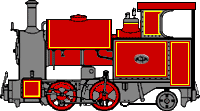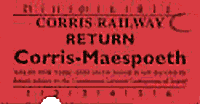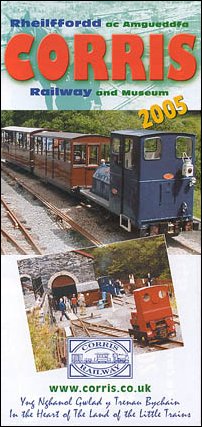











Corris Railway
Station Yard Corris
Machynlleth Powys
Wales United Kingdom
N52.653564 W3.841685 (Corris Platform)
(Corris Platform)
Welsh slate has been the driving force behind many narrow gauge railways in Wales and the Corris is also one of these. The north/south route of the railway up and down the Dulas Valley connected several slate quarries to a wharf in Machynlleth and later to a standard gauge railway which runs generally east/west providing a trans-shipment point to the rest of Britain.
Lying along this Dulas Valley route the Ratgoed, Aberllefenni, Abercwmeiddaw, Abercorris, Gaewern, Braichgoch, and Llwyngwern slate quarries provided the reason for the little railway to survive as long as it did. It is my understanding the quality of Dulas Valley slate is not quite as fine as slate from the Blaenau Ffestiniog region where the best quality roofing slate is produced. Therefore large slabs of slate used for architectural, monumental, landscaping, and civil engineering purposes were transported by the Corris Railway which had specially designed cars known as Aberllefenni Slab Waggons . (Editor's note: It's a Corris tradition to spell wagon as "waggon" which is the way I always figured it should be spelled anyway.) These waggons are comprised of a wood frame atop a four-wheel metal chassis. The Aberllefenni quarry was the last operating quarry in the Dulas Valley being worked until 2003 when test coring was unable to locate a new chamber that would be economically viable.
. (Editor's note: It's a Corris tradition to spell wagon as "waggon" which is the way I always figured it should be spelled anyway.) These waggons are comprised of a wood frame atop a four-wheel metal chassis. The Aberllefenni quarry was the last operating quarry in the Dulas Valley being worked until 2003 when test coring was unable to locate a new chamber that would be economically viable.
The Corris Railway's origin dates back to the 1850's. The line was initially built as a horse and gravity worked tramway to carry slate from the quarries of Corris Uchaf and Aberllefenni to a navigable point on the Afon Dyfi (Dovey River). There slate was loaded into ships and carried to its diverse destinations. In the 1860's the line ceased shipping to the wharf and instead trans-shipped slate to the standard gauge railway at Machynlleth. A semi-official passenger service, using adapted wagons, flourished in the early 1870s.
In 1878 the line was acquired by a London company, Imperial Tramways Limited, and three steam locomotives and ten purpose-built passenger carriages were introduced. Due to a dispute with the quarry owners passenger services were suspended until 1883. During the rest of the nineteenth century the Railway was very prosperous, developing a substantial tourist traffic.
The twentieth century brought with it a decline in the slate industry, followed by increasing competition from road transport. The railway ran its own successful bus services, using vehicles provided from Bristol, and it was probably more from a desire to control these services than to acquire the Corris Railway itself that led to the Great Western Railway purchasing the line from Imperial Tramways in 1930. Soon afterwards passenger services were withdrawn. The line continued in use for goods only until 1948, when it became one of the first to be closed by the newly-nationalized British Railways. The last train ran in 1948 and the line was dismantled soon after closure while the surviving locomotives and rolling stock found a new life on the nearby Talyllyn Railway.

In the 1960s a group of Talyllyn volunteers decided to try to preserve something of the Corris route which had almost disappeared under encroaching vegetation. The Corris Railway Society was formed in 1966 and reached its first landmark in 1970 when the Corris Railway Museum was opened in the former railway stable. The following year a few hundred yards of "demonstration track" was laid adjacent to the museum. In 1981 the old engine shed at Maespoeth was refurbished into a maintenance shed and workshop.
Laying of track between Corris and Maespoeth began in 1984 and the first train in 37 years ran the following year. Approval to operate a passenger service was finally given on 15 March 2002, and the first fare-paying passenger train in 72 years left Corris Station on 3 June 2002.
Initial passenger services in 2002 were run by a train consisting of diesel loco No. 6, carriage 20, named "Tiger" which was constructed on a former Coal Board four-wheel man rider chassis, and van 204 adapted from a former Royal Navy vehicle. In June of 2003 bogie carriage number 21 (based on carriages that served the line from 1888 to 1930, but built to 21st century safety standards) was brought into service. Constructed by Society members in the East Midlands, it includes provision for carrying wheelchairs.
In addition a range of goods vehicles, sourced from all over the country, and re-gauged to suit were assembled. Society members restored four original waggons from the railway or quarries. These will form the basis for demonstration mixed trains reminiscent of those that ran on the line in the 1920s.
Construction of new steam locomotive Number 7, named "Tattoo", was completed in 2005. It is now operable at Maespoeth and commenced passenger service once official government approval was granted.
The Corris Railway Company Limited, formed by the Society to operate the railway, is seeking to reinstate some two and a half miles of the old line, from Corris to Tan-y-Coed about midway between the original stations at Esgairgeiliog and Llwyngwern. Currently Llwyngwern is the site of the Forestry Commission's picnic site and is within walking distance of the Centre for Alternative Technology.
Permission has been received from the landowners to clear undergrowth on the track bed south of the existing railhead to the planned new southern terminus at Tan-y-Coed. It won't be possible to begin track laying on this section until a Transport & Works Order has been obtained. Progress on this Order continues steadily. The only serious physical obstruction on this section has been caused by road improvements at Pont-y-Goedwig, south of Maespoeth, where the track bed formation has been breached. The Company has acquired the land necessary to construct a deviation around this obstacle.
With trains currently operating push-pull between Corris and Maespoeth, due to a lack of run-around loops, construction of a loop at Maespoeth making use of land acquired from the adjacent field has commenced. This will eventually lead onto the mainline south towards Tan-y-Coed.
Once the line is complete from Corris to Tan-y-Coed, the Society hopes to be able to arrange joint ticketing with the Centre for Alternative Technology and King Arthur's Labyrinth (close to Corris Station in the former Braichgoch Quarry) and encourage visitors to leave their cars at one end or other and use the railway as a means of enjoying the "Dulas Valley Experience" - Corris Railway Society.

In 2005 the Corris Railway published this leaflet with information for visitors to the railway and the museum at Corris in the land of the little trains of Wales.
On Saturday, 20 Aug 2005, Corris Railway steam-hauled passenger service commenced with engine number 7 Tattoo
commenced with engine number 7 Tattoo which happened to be the fifty-seventh anniversary of the last train (goods-only) to run on the original railway.
which happened to be the fifty-seventh anniversary of the last train (goods-only) to run on the original railway.
The Corris Railway is slowly re-constructing the railway line south of Maespoeth as funds become available. The immediate goal is to lay track as far south as Pont Evans with the final goal of reaching Tan-y-Coed. On-going negotiations with government authority is required due to the closeness of the line to the A487 trunk road. Because the A487 was built over the old trackbed this means a new embankment must now be constructed including a a bridge over the Goedwig River. Work commenced in 2015. As a result of these difficulties a phased approach will be taken in the effort to reach Tan-y-Coed. The first phase destination has been designated Goedwig South where a run-around will be constructed for the locomotive so trains can return to Maespoeth.
By March 2020 official permissions were in place for embankment construction when the world wide pandemic struck. However, suitable fill was obtained from Dolgellau which was transported to the work site even with COVID-19 restrictions in place. Costing more than £70,000, and with the Goedwig River bridge still to be built, presently there is a pause in construction at this time. Donations to the Southern Extension Appeal will get the railway moving towards Goedwig South once again.
Donations can be made via www.corris.co.uk or cheques payable to "Corris Railway" can be sent to the Corris Railway, Station Yard, Corris, Machynlleth, SY20 9SH.